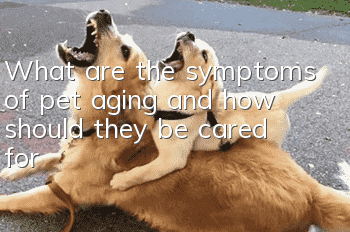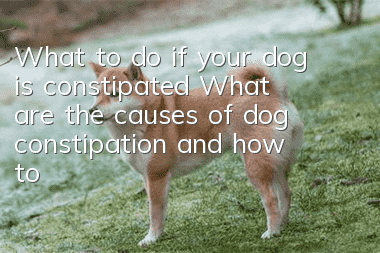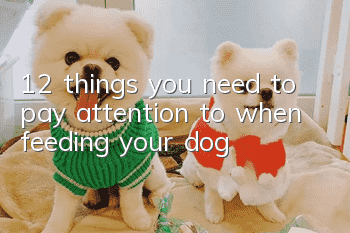What are the symptoms of pet aging and how should they be cared for?

All living things in the world are inseparable from birth, old age, illness and death. People know that the life span of pets and humans is very different. Maybe when you were a child, you grew up with a puppy, but when you grow up, the puppy may be old or gone. Dogs have established a very deep relationship with humans, and it is very sad to lose a dog that you have been with day and night. Therefore, when your dog starts to age, you must take good care of it to make it live longer.
What are the symptoms of pet aging?
Vision loss
Decreased vision, the eyes are no longer clear and translucent, and there is cloudiness in the eyeballs, which may be a sign of cataracts.
Hearing loss
If your pet is slow to respond and sometimes does not respond when you call it, it is not because it is arrogant and ignores you, or it may be that it does not hear you at all.
Dental disease
If you don’t have the habit of brushing your teeth, your gums will be easily eroded by bacteria, causing gum recession, loosening of teeth, and affecting eating.
The energy is no longer strong
Pets that have begun to enter their aging period do not have as much energy as they did in their teenage years. They get tired easily, lose interest in exercise and play, and sleep longer.
The hair quality deteriorates
When a pet reaches a certain age, its hair begins to become lighter and sparse, its hair becomes dry and rough, and its hair begins to be mixed with white hairs. This is a normal physiological characteristic.
Joint problems
As pets age, their joints begin to age. They may experience difficulty walking inside and outside, weakness in their limbs, reluctance to stand or walk, and a limp when walking. These may be signs of joint problems, accompanied by pain.
If you have a medium-to-large dog such as a Golden Retriever or an Alaskan, or if your furry child is obese, their joints will have a heavier load, so you need to pay special attention.
When your pet has more than one of the above symptoms, you need to pay special attention to it
Regular physical examination
An annual physical examination is essential in order to detect hidden dangers in time and provide early diagnosis and treatment.
Many diseases, such as cardiovascular disease, tumors, kidney disease, diabetes, etc., once there are obvious symptoms, most of them have entered the middle and late stages.
Early detection, early treatmenttreatment. Taking timely treatment measures can reduce your pet's pain and extend its life.
Don’t change your living habits easily
If you love your pet’s previous habits (diet, work and rest, etc.), unless the previous habits are extremely unscientific, don’t break it’s normal life easily.
Stay away from danger
If your pet shows signs of vision and hearing loss, it is best for parents to control it with petting or gestures instead of yelling at it.
Be careful to keep it away from dangers, such as cars, that he may not hear or see.
Be sure to wear a leash when going out to prevent mishaps such as getting lost or being involved in a car accident.
Regular teeth cleaning
If you don’t have the habit of brushing your teeth, you will easily develop dental calculus, which can lead to periodontal disease and stomatitis. As pets get older, their teeth tend to loosen, making it difficult to eat. Brushing your teeth regularly can effectively prevent these conditions.
Exercise appropriately every day and refuse strenuous exercise
Pets entering the aging period should no longer engage in strenuous activities such as running and climbing as they did in young adults. In order to meet their daily exercise needs, daily walks are enough. The time should not be too long, preferably 30 minutes.
Joints need attention
Research reports indicate that about 33% of cats over 6 years old have osteoarthritis and degenerative arthritis, and 90% of cats over 12 years old have osteoarthritis and degenerative arthritis. 80% of canine arthritis occurs over the age of 8 years.
Therefore, parents need to take precautions in advance.
Prevention methods:
Weight control. Excessive weight pressure can cause damage to joints.
Avoid high-impact exercises. During exercise, you need to take breaks every once in a while to reduce joint strain.
If the floor at home is too slippery, you can lay out non-slip floor mats to prevent pets from slipping and injuring their joints when running around at home.
At the same time, it is recommended to regularly cut the fur on the soles of pets' feet to expose the flesh pads to prevent slipping.
- How to get rid of heavy body odor in dogs
- How to train a dog not to lick people? The answers are all here!
- What did pugs eat when they were young?
- Where is the origin of huskies?
- What should I do if my dog keeps picking up food everywhere when I go out?
- What are the symptoms of hyperthyroidism (hyperthyroidism) in dogs?
- What rewards should be used for puppy training? Teach you some dog training tips!
- How to treat diarrhea in pregnant dogs?
- How many months should you start training a German Shepherd? The best time to train a German Shepherd!
- When is the best month to train a Lala? The best age to train a Lala!



